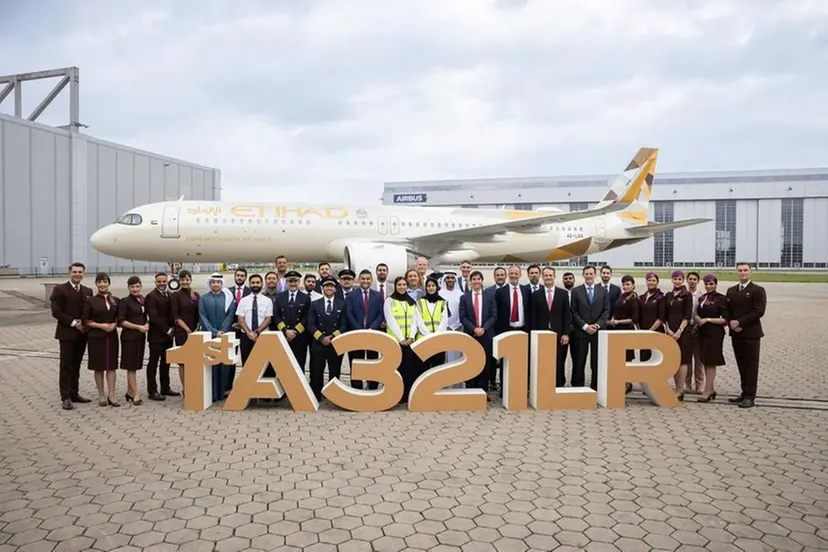Etihad Airways has taken supply of its first Airbus A321LR (lengthy vary) following ceremony on the Airbus Finkenwerder web site, marking a transformational milestone within the airline’s fleet enlargement technique. The plane brings Etihad’s signature widebody expertise to brief and medium-haul routes, with premium cabins sometimes discovered solely on long-haul flights. That is the primary of 30 A321LR plane scheduled to hitch Etihad’s fleet.
Antonoaldo Neves, Chief Government Officer of Etihad Airways, stated: “At present marks a rare second for Etihad as we welcome an plane that modifications every thing we thought attainable on a single-aisle airplane. The A321LR allows us to serve extra locations with the identical premium expertise our visitors anticipate throughout all cabins, completely embodying our dedication to delivering luxurious at each altitude.”
Redefining Narrowbody Journey
The A321LR contains a three-cabin configuration, together with Etihad’s first-ever narrowbody First Suites – non-public, enclosed areas with sliding doorways, fully-flat beds, and bespoke design touches usually reserved for long-haul widebody operations. Every window-facing First Suite options a big 20-inch 4K display, Bluetooth pairing, wi-fi charging, and extra house for a companion to take a seat.
The plane’s 14-seat Enterprise cabin options widebody-style seats in a 1-1 herringbone format, guaranteeing each passenger has direct aisle entry and window views. Every Enterprise seat features a 17.3-inch 4K display, Bluetooth headphone pairing and wi-fi charging.
In Financial system, 144 thoughtfully designed seats supply beneficiant house and luxury, offering an elevated expertise for single-aisle journey. Passengers get pleasure from 13.3-inch 4K touchscreen shows, USB charging, and Bluetooth connectivity. These seatback screens carry premium content material again to narrowbody journey with over a thousand hours of films, reveals and video games.
As well as, the cabin options enlarged overhead bins offering considerably extra baggage house than conventional narrowbody plane.
Benoît de Saint-Exupéry, Airbus Government Vice President Gross sales of the Industrial Plane Enterprise, commented: “The supply of Etihad’s first Airbus A321LR is a strong image of innovation and partnership, strengthening the long-standing relationship between Airbus and the UAE. This plane units a brand new customary for consolation within the single-aisle class and paves the way in which for elevated connectivity as Etihad expands its operations from its Abu Dhabi hub.”
Staying Related Above the Clouds
A standout characteristic of Etihad’s A321LR is its high-speed Wi-Fi powered by Viasat’s superior expertise delivering speeds of as much as 100’s of Mbps. Passengers can get pleasure from seamless streaming, gaming and shopping all through their journey, bringing ground-level connectivity to the skies. This gate-to-gate connectivity, the place permitted, ensures visitors stay productive and entertained whether or not flying for enterprise or leisure. Wi-Fi service on Asian routes is being progressively rolled out and might be accessible from September 2025.
Increasing Horizons
The A321LR helps Etihad’s extraordinary enlargement momentum, with the airline having launched or introduced 27 new routes in a single yr as a part of its formidable development technique. The plane will enter industrial service on 1 August 2025, initially working between Abu Dhabi and Phuket earlier than serving locations together with Algiers, Bangkok, Chiang Mai, Copenhagen, Düsseldorf, Kolkata, Krabi, Krakow, Medan, Milan, Paris, Phnom Penh, Phuket, Tunis and Zurich.
The A321LR supply helps Etihad’s Journey 2030 imaginative and prescient, reinforcing Abu Dhabi’s place as a number one world aviation hub. Extra 9 A321LR plane might be delivered all through 2025, supporting Etihad’s formidable development plans because the airline works in the direction of carrying 38 million passengers yearly by 2030.

